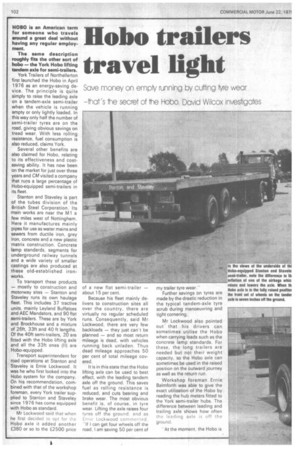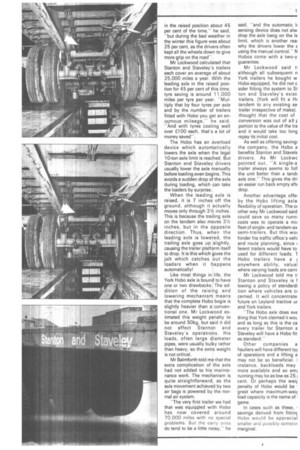Hobo trailers
Page 104

Page 105

If you've noticed an error in this article please click here to report it so we can fix it.
travel light
Save money on empty running by cuthng ye wear -that's ne secret of the Hobo, David Wilcox investigates
HOBO is an American term for someone who travels around a great deal without having any regular employment.
The same description roughly fits the other sort of hobo — the York Hobo lifting tandem axle for semi-trailers.
York Trailers of Northallerton first launched the Hobo in April 1976 as an energy-saving device. The principle is quite simply to raise the leading axle on a tandem-axle semi-trailer when the vehicle is running empty or only lightly loaded. In this way only half the number of semi-trailer tyres are on the road, giving obvious savings on tread wear, With less rolling resistance, fuel consumption is also reduced, claims York.
Several other benefits are also claimed for Hobo, relating to its effectiveness and costsaving ability. It has now been on the market for just over three years and CM visited a company that runs a large percentage of Hobo-equipped semi-trailers in its fleet.
Stanton and Staveley is part of the tubes division of the British Steel Corporation. Its main works are near the M1 a few miles west of Nottingham. Here it manufactures mainly pipes for use as water mains and sewers from ductile iron, grey iron, concrete and a new plastic matrix construction. Concrete lamp standards, segments for underground railway tunnels and a wide variety of smaller castings are also produced at these old-established ironworks.
To transport these products — mostly to construction and motorway sites — Stanton and Staveley runs its own haulage fleet. This includes 37 tractive units, mainly Leyland Buffaloes and AEC Mandators, and 90 flat semi-trailers. These are by York and Brockhouse and a mixture of 26ft, 33ft and 40 ft lengths. Of the 40ft semi-trailers, 20 are fitted with the Hobo lifting axle and all the 33ft ones (II) are Hobo-equipped.
Transport superintendent for road operations at Stanton and Staveley is Ernie Lockwood. It was he who first looked into the Hobo system for the company. On his recommendation, combined with that of the workshop foreman, every York trailer supplied to Stanton and Staveley since 1976 has come equipped with Hobo as standard.
Mr Lockwood said that when he first decided to opt for the Hobo axle it added another £380 or so to the £2500 price of a new flat semi-trailer — about 1 5 per cent.
Because his fleet mainly delivers to construction sites all over the country, there are virtually no regular scheduled runs. Consequently, said Mr Lockwood, there are very few backloads — they just can't be planned — and so most return mileage is dead, with vehicles running back unladen. Thus dead mileage approaches 50 per cent of total mileage covered.
It is in this state that the Hobo lifting axle can be used to best effect, with the leading tandem axle off the ground. This saves fuel as rolling resistance is reduced, and cuts bearing and brake wear. The most obvious benefit is, of course, in tyre wear. Lifting the axle raises four tyres off the ground and as Ernic Lockwood commented 'If I can get four wheels off the road, I am saving 50 per cent of my trailer tyre wear.'" Further savings on tyres are made by the drastic reduction in the typical tandem-axle tyre scrub during manoeuvring and tight cornering.
Mr Lockwood also pointed out that his drivers can sometimes utilise the Hobo when carrying loads such as the concrete lamp standards. For these, the long trailers are needed but not their weight capacity, so the Hobo axle can sometimes be used in the raised position on the outward journey as well as the return run.
Workshop foreman Ernie Balmforth was able to give the exact utilisation of the Hobo by reading the hub meters fitted to the York semi-trailer hubs. The difference between leading and trailing axle shows how often the leading axle is off the ground.
-At the moment, the Hobo is
in the raised position about 45 per cent of the time," he said, "but during the bad weather in the winter this figure was about 25 per cent, as the drivers often kept all the wheels down to give more grip on the road".
Mr Lockwood calculated that Stanton and Staveley's trailers each cover an average of about 25,000 miles a year. With the leading axle in the raised position for 45 per cent of this time, tyre saving is around 11,000 miles per tyre per year. "Multiply that by four tyres per axle and by the number of trailers fitted with Hobo you get an enocmous mileage," he said. "And with tyres costing well over £.100 each, that's a lot of money saved".
The Hobo has an overload device which automatically lowers the axle when the legal 10-ton axle limit is reached. But Stanton and Staveiey drivers usually lower the axle manually before loading even begins. This avoids a sudden drop of the axle during loading, which an take the loaders by surprise.
When the leading axle is raised, it is 7 inches off the ground, although it actually moves only through 31/2 inches. This is because the trailing axle on the tandem also moves 31/2 inches, but in the opposite direction. Thus, when the leading axle is lowered, the trailing axle goes up slightly, causing the trailer platform itself to drop. It is this which gives the jolt which catches put the loaders when it happens automatically!
Like most things in life, the York Hobo axle is bound to have one or two drawbacks. The addition of the raising and lowering mechanism means that the complete Hobo bogie is slightly heavier than a conventional one. Mr Lockwood estimated this weight penalty to be around 50kg, but said it did not affect Stanton and Staveley's operations. His loads, often large diameter pipes, were usually bulky rather than heavy, so the extra weight is not critical.
Mr Balmforth told me that the extra complication of the axle had not added to his maintenance work. The mechanism is quite straightforward, as the axle movement achieved by two air bags is powered by the normal air system.
"The very first trailer we had that was equipPed with Hobo has now covered around 70,000 miles with no special problems. But the early ones do tend to be a little noisy," he said, "and the automatic k sensing device does not alw drop the axle bang on the le limit, which is another reai why the drivers lower the z' using the manual control." N Hobos come with a two-y guarantee.
Mr Lockwood said tI although all subsequent n York trailers he bought w Hobo-equipped, he did not c sider fitting the system to St ton and Staveley's exist trailers. (York will fit a I-1( tandem to any existing se trailer irrespective of make). thought that the cost of conversion was out of all portion to the value of the tra and it would take too long repay its initial cost.
As well as offering saving: the company, the Hobo a benefits Stanton and Stavelc drivers. As Mr Lockwc pointed out, "A single-a trailer always seems to foil the unit better than a tand( axle one." This gives the clri an easier run back empty afti drop.
Another advantage. offel by the Hobo lifting axle flexibility of operation. The oi other way Mr Lockwood said could save so many runni costs was to operate a me fleet of singleand tandem-ax semi-trailers. But this wol hinder his traffic office's vehi and route planning, since ferent trailers would have to used for different loads. Hobo trailers have a anywhere ability, valual where varying loads are car6
Mr Lockwood told me tI Stanton and Staveley is I lowing a policy of standardi tion where vehicles are C4 cerned. It will concentrate future on Leyland tractive Ur and York trailers.
-The Hobo axle does eve thing that York claimed it woi. and as long as this is the ca every trailer for Stanton a Staveley will have a Hobo fit as standard. F
Other companies a hauliers will have different tyj of operations and a lifting a may not be so beneficial. I instance, backloads may more available and so emi running may be as low as 25 I cent. Or perhaps the vvei penalty of Hobo would be • great where maximum-weis load capaicity is the name of game.
In cases such as these, • savings derived from fittinc Hobo would be apprecial smaller and possibly sornetin marginal,




























































































































































































